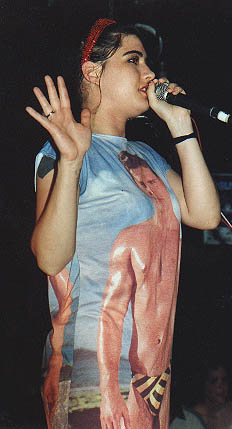feminism 101: what in the world is a ‘riot grrrl’?
When I think of ’90s feminism, the things that come to mind are angry girls, Xena: Warrior Princess and Ellen Degeneres’ coming out. Third-wave feminism has a bit of a reputation for punk music, opinionated zines and a major divide between men and women. Smack-bang in the middle of all this activism was an underground, feminist punk movement called Riot Grrrl.
Riot Grrrl was largely created by members of the all-female punk bands Bratmobile and Bikini Kill. They were wildly pissed off at America’s male-dominated punk scene where women were deliberately excluded. Lead singer of Bratmobile, Allison Wolfe, explained in the documentary Don’t Need You – The Herstory of Riot Grrrl that gigs became gender divided. Men would take over the floor and women would stand at the edges, holding the coats of their male friends, unable to penetrate the aggressive dancing and make their way to the front.
Riot Grrrl mainly focused on the creation of punk music that represented women. Bands like Calamity Jane, Heavens to Betsy and Bangs used music to address issues of domestic abuse, rape, sexuality and female empowerment. Their lyrics were designed to reclaim the music scene for women.
Riot Grrrl had a DIY attitude in that they produced their own media. They were self-taught musicians, artists and writers who independently hosted gigs, created films and printed zines. The documentary Grrrl Love and Revolution addresses the issue of media in the early ’90s and how inaccessible it had become. One Riot Grrrl explained that ‘What Riot Grrrl and a lot of other women… have done is produce their own media and flood the media system in whatever way they can and say “No, this is what a woman wants, this is what a woman is” and people were willing to pay for it and accept more challenging media’.
The aim of Riot Grrrl was to address issues surrounding women that were hushed within society. Sexual abuse was a huge problem that rose to the surface during the movement. Grrrl Love and Revolution focuses on abuse and explains that Riot Grrrl meetings created a safe space where women could open up.
‘A lot of them [women] weren’t really sure, they’d just had dreams, memories, flashbacks and were just putting together the pieces, finally recognising what had happened to them, it seemed like the more everybody opened up, the more we realised what had happened. Hopefully if people can be open about it, it won’t happen so much.’
The 1996 documentary Dirty Girls focused on a branch of Riot Grrrl and is proof that the movement affected young women and their impression of the world. “Dirty Girl”, Amber Willat, when asked if she considered herself a Riot Grrrl, responded with, ‘Yeah, I do. I think that a Riot Grrrl is someone who doesn’t believe in the way that women are treated in society right now. Not only women, it also has to do with any prejudice like racism or sexism or even against gays and bisexuals and we really hate that kind of stuff and we’re willing to stand up against it.’
Riot Grrrl affected these young women in that they were inspired to dress for themselves, speak out against prejudice and produce their own zine.
Riot Grrrl was a loud and active movement that aimed to eradicate gender division and discrimination against women. It had a large impact on the punk music scene and mainstream media. It infiltrated pop-culture with the creation of strong female characters in TV shows such as Buffy the Vampire Slayer and Xena: Warrior Princess.
Twenty years on, the movement has dwindled off, but their fierce work has added to the way society perceives women. Their initial desire to reclaim the music industry has progressed to the point that female musicians don’t need to fight to be taken seriously. ’90s hardcore band Fugazi was also known for their DIY attitude and hatred of the music industry. Lead singer Ian MacKaye said that ‘Even in the ’80s, if I were to go see a punk band and there was a girl drumming, I would say, “Hey, they’re cool, they’ve got a girl drumming”, if I see a band now, it never occurs to me what the gender is.’
Riot Grrrl had a fierce passion that drove women to sing and write and protest. Loudly. A loud passion seems to be somewhat lacking from feminism today. Perhaps we’re a little worried about coming across as aggressive and the negative comments that accompany that sort of passion. Maybe should steer clear of their aggression and instead borrow from their enthusiasm; muster up some Riot Grrrl passion and stir-up this stagnant fight for equality.



Pingback: 5 Incredible Music Documentaries Every Musician Must See - Smokin Underground Smokin Underground
Pingback: Stock Age Music | Music Documentaries You Must See